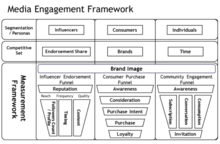Media engagement framework

The media engagement framework is a strategic construct used by marketing professionals to understand the behavior of Social media marketing[1]-based audiences.
The media engagement framework consists of the definitions of personas (Individuals, Consumers and Influencers),[2] referenced by the competitive set or constraint that applies to that persona and the measurement framework that might be applied to those personas. It is referenced first at the center of the marketing process diagram, surrounded by the marketing functions of strategy, tactics, metrics and ROI. The marketing process diagram describes how the media engagement framework can apply to any strategic marketing activity but was developed to establish a completely integrated framework describing how both traditional and social media marketing activities can be planned, executed, measured and improved.[3]
Application
The media engagement framework provides a strategic planning construct in which measurements and metrics play a crucial role in the development and improvement of those strategies and tactics. Applying the media engagement framework aids in the development and management of an effective online marketing presence leveraging social media to engage a market or audience.[4] By first personifying the audience, the marketer is able to identify the limiting aspect of the engagements possible with that audience segment and then, understand the type of engagement metrics to apply. Each persona makes decisions differently about how he/she acts in the social media universe. With this in mind specific a framework metric can be applied for each of these personas:
- Endorsement funnel for influencers
- Community engagement funnel for individuals
- Purchase funnel for consumers
Within each persona marketers must realize that individuals, influencers and consumers make decisions based on alternatives available to them and constraints put on them. To engage with an individual brands must realize they are competing against the time an individual spends on line. If they find something else more engaging, they will engage with that activity. Brands compete against other brands for the purchases of consumers acting in the category. Lastly, influencers have only so many endorsements they can make and therefore brands compete with other endorsers for the endorsement of an influencer.
Use of listening tools (Google Alerts, Twitter Search, SocialMention.com, Veooz.com, Alterian SM2, Radian6, Sysomos, Buzzient etc.) can be employed within the model to help identify the members of the audience segment and to support the formation of other social engagement planning and management tools.
Origin
The construct was introduced in the book, ROI of Social Media.[5] Guy R. Powell’s extensive background in marketing ROI and Groves' experience and understanding of the emerging applications of social media in business led to a collaboration. Dimos joined as a brand strategist for Litmus Group, a global management consulting firm. The three authors created the media engagement framework over several months of definition, refinement, client applications and then finally creating its initial form for publication in the ROI of Social Media.
See also
References
- ↑ Gold, Tommy. "Engagement of Dental Social Media Marketing". Retrieved 22 October 2014.
- ↑ http://onlinelibrary.wiley.com/doi/10.1002/9781119199403.ch6/summary
- ↑ http://www.sciencedirect.com/science/article/pii/S0268401215000249
- ↑ http://igautolike.com/how-will-social-media-affect-marketing-for-2016/
- ↑ Powell, Guy; Groves, Dimos (2011). ROI of Social Media: How to Improve the Return on Your Social Marketing Investment. Asia: John Wiley & Sons. p. 320. ISBN 978-0-470-82741-3.